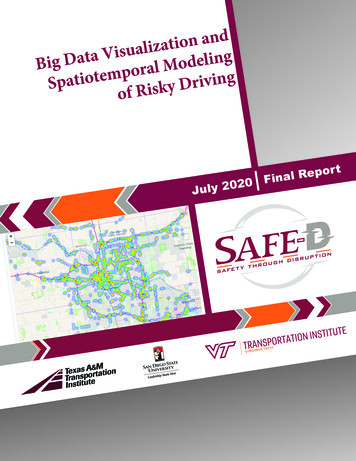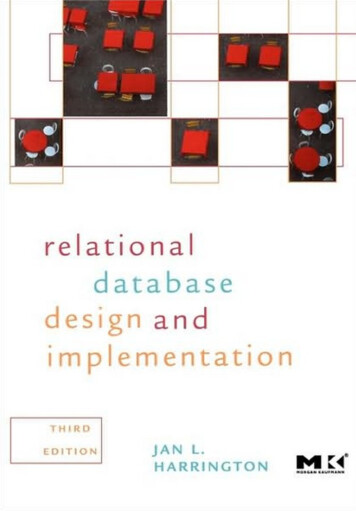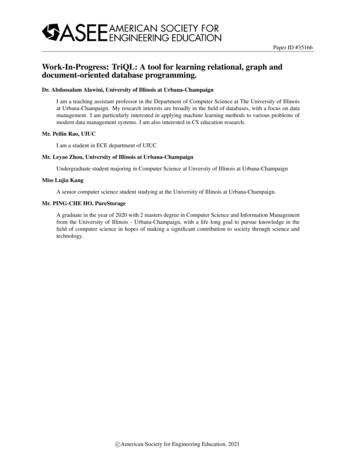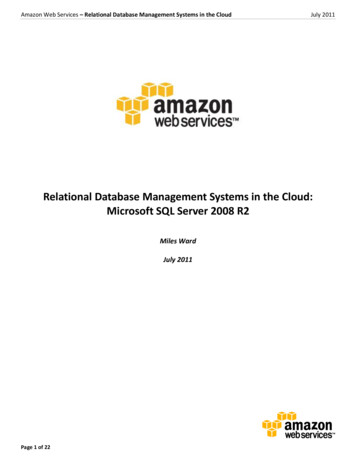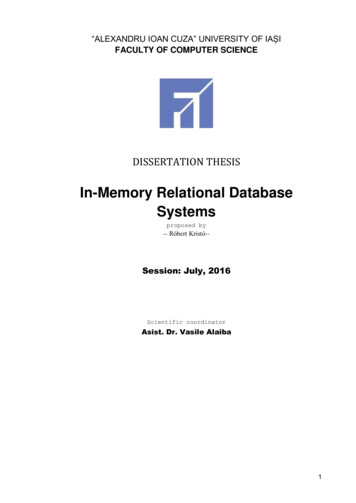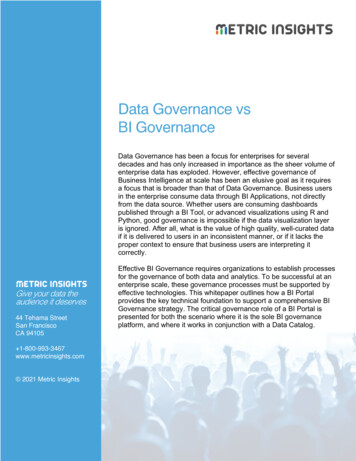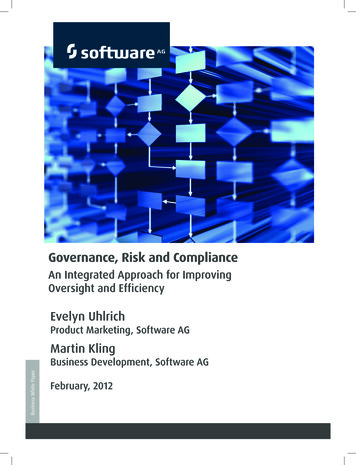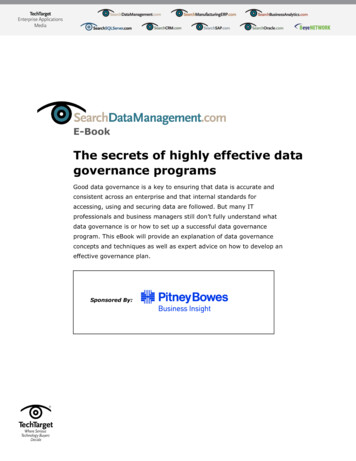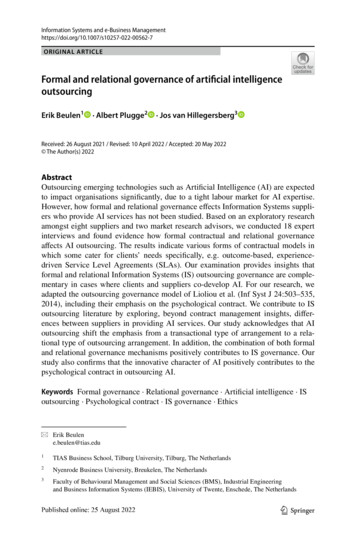
Transcription
Information Systems and e-Business -7ORIGINAL ARTICLEFormal and relational governance of artificial intelligenceoutsourcingErik Beulen1· Albert Plugge2· Jos van Hillegersberg3Received: 26 August 2021 / Revised: 10 April 2022 / Accepted: 20 May 2022 The Author(s) 2022AbstractOutsourcing emerging technologies such as Artificial Intelligence (AI) are expectedto impact organisations significantly, due to a tight labour market for AI expertise.However, how formal and relational governance effects Information Systems suppliers who provide AI services has not been studied. Based on an exploratory researchamongst eight suppliers and two market research advisors, we conducted 18 expertinterviews and found evidence how formal contractual and relational governanceaffects AI outsourcing. The results indicate various forms of contractual models inwhich some cater for clients’ needs specifically, e.g. outcome-based, experiencedriven Service Level Agreements (SLAs). Our examination provides insights thatformal and relational Information Systems (IS) outsourcing governance are complementary in cases where clients and suppliers co-develop AI. For our research, weadapted the outsourcing governance model of Lioliou et al. (Inf Syst J 24:503–535,2014), including their emphasis on the psychological contract. We contribute to ISoutsourcing literature by exploring, beyond contract management insights, differences between suppliers in providing AI services. Our study acknowledges that AIoutsourcing shift the emphasis from a transactional type of arrangement to a relational type of outsourcing arrangement. In addition, the combination of both formaland relational governance mechanisms positively contributes to IS governance. Ourstudy also confirms that the innovative character of AI positively contributes to thepsychological contract in outsourcing AI.Keywords Formal governance · Relational governance · Artificial intelligence · ISoutsourcing · Psychological contract · IS governance · Ethics* Erik Beulene.beulen@tias.edu1TIAS Business School, Tilburg University, Tilburg, The Netherlands2Nyenrode Business University, Breukelen, The Netherlands3Faculty of Behavioural Management and Social Sciences (BMS), Industrial Engineeringand Business Information Systems (IEBIS), University of Twente, Enschede, The Netherlands13Vol.:(0123456789)
E. Beulen et al.1 IntroductionEmerging technologies, such as robotic process automation, machine learning, neural networks and complex algorithms, often referred to as Artificial Intelligence(AI), are expected to impact organisations significantly (Willcocks 2020). Recentstudies on AI reveal its potential to help solve current problems in the field of dataprocessing and business process optimisation. On the other hand, concerns areraised about the potential of AI to support wrong decision-making (Dignum 2018;Floridi et al. 2018). Market research shows that the 2025 market size of AI will growto 232 billion compared to an estimated 12.4 billion today (KPMG 2018). McKinsey’s survey report on AI shows that AI adoption is highest in product or servicedevelopment and service operations (McKinsey Research 2020), where Gartnerindicates the most important trend for 2020 as ‘smarter, faster, more responsible AI’and that ‘by the end of 2024, 75% of enterprises will shift from piloting to operationalizing AI, driving a 5X increase in streaming data and analytics infrastructures’(Gartner 2020). This fits within the service-oriented approach of organisations todayto improve internal business services (Plugge et al. 2020). As AI skills are globallyin demand, outsourcing of AI is a means to address this shortage in general (Anderson et al. 2020; Dawson 2021) or in specific domains, such as cyber security (Smiths2018).Although there is no consensus on a common definition of AI (Legg and Hutter 2007; Wang 2019), Dwivedi et al. (2021, p. 2) argue that ‘the common threadamongst AI definitions is the increasing capability of machines to perform specificroles and tasks currently performed by humans within the workplace and society ingeneral’.This description includes machines that mimic cognitive functions, such aslearning, speech and problem-solving (Russell and Norvig 2016) and the ability toindependently interpret and learn from external data (Kaplan and Haenlein 2019).Also responsibilities for AI lack clarity. This includes gaps in four areas: culpability, moral and public accountability and active responsibility (de Sio and Macacci2021). Especially the latter is relevant in the context of AI outsourcing.Given the fast pace and complexity of AI technologies, larger organisationsadopting AI usually engage in outsourcing relationships with leading suppliers ofAI systems, consulting and services. This is part of a broader digital transformationoutsourcing trend (Beulen and Ribbers 2020), where artificial intelligence enablesdigital transformations (Magistretti et al. 2019; Calp 2020; Holmstrom 2021).Leading suppliers in this field include Accenture, Atos, Boston ConsultingGroup, EY, HCL, KPMG, McKinsey and Tata Consultancy Services, as well asmany other established and niche suppliers. As the impact of AI on business is ofstrategic importance, AI outsourcing needs to be carefully governed. Kranz (2021)argues that there is statistical evidence that contractual governance plays a key rolein Information Systems (IS) arrangements. This is supported by industry, for example by the COBIT framework that consists of 40 Governance and ManagementObjectives, including the objectives ‘managed service agreements’ (APO09) and‘managed vendors’ (APO10) (De Haes et al. 2020). However, there is no research13
Formal and relational governance of artificial intelligence on how formal AI contracts are established. Moreover, the way clients and supplierscope with relational governance, including psychological contracts (Argyris 1960;Levinson et al. 1962), in the context of AI is unknown.We aim to fill this research gap by presenting a study that examines governance of AI outsourcing in an in-depth, qualitative manner. To broaden our view ongovernance for AI outsourcing, we examine formal and relational governance elements, including a psychological contract, as part of the client-supplier outsourcingarrangement. These elements have to be taken into account, not only by clients andsuppliers, but also by IS sourcing advisors. To the best of our knowledge, formal andinformal governance in the context of AI outsourcing has not been studied before.In doing so, we answer the call of Kranz (2021) to study the implementation of contractual models and its effect on governance and relationship outcomes. Moreover,we extend the study by Linden and Rosenkranz (2019) on relational governance inthe context of AI outsourcing. Hence, the main research question of this paper is:How are formal and relational governance used in artificial intelligence outsourcing?The contribution of this study is to make an inventory of the current AI outsourcingpracticesby focusing on formal and relational governance. This paper is organisedas follows. First, our theoretical background addresses the concepts of governancefor AI outsourcing. Subsequently, we introduce a research framework, based on theoutsourcing governance framework of Lioliou et al. (2014). The research method ispresented in Sect. 3, and the data analysis and results are described in Sect. 4. Discussions and conclusions are presented in Sect. 5 and 6, respectively.2 Theoretical background2.1 Artificial intelligenceHaenlein and Kaplan argue that in the 1950’s the academic discipline of AI has beenestablished, however “AI remained an area of relative scientific obscurity and limited practical interest for over half a century.” (2019, p. 5). Literature shows that AIhas been studied from an augmentation perspective, arguing that AI should supporthumans in decision-making (Miller 2018; Duan et al. 2020). This is consistent withthe research of Davenport and Ronanki (2018) in which the authors argue that AIsystems are not able to explain the reasoning process of decision-making, and assuch are supportive of human judgement. As an example, the authors address therole of deep learning as a means to learn from large volumes of labelled data. However, it is almost impossible to understand the models that are designed to executeits functionality. This AI “black box” may cause problematic issues, for instance inregulated sectors, as regulators insist on knowing why and how decisions are made.Thus, AI can be perceived as an awareness system that is supportive of humans inorder to increase the visibility of events or states (Krancher et al. 2018) and mayadd business value to organisations by means of technology (Sabherwal and Jeyaray13
E. Beulen et al.2015). Tarafdar et al. (2019) demonstrates in their study on AI that successfulorganisations which are able to create value radically improved their business processes. In doing so, AI aids organisations to process more data that support humandecision-making.However, when AI systems, such as intelligent Information Technology (IT)service management systems (Zhang 2021), rely on dispersed, low quality, missing or inconsistent data, conventional organisations are challenged by successfullyintegrating data, which in turn may result in biased or incorrect decision-making.Meaningful human control is required (de Sio and Mecacci 2021). Due to involvingsuppliers, ensuring this has become more difficult, as AI services in outsourcing areperformed at arms-length.This may also lead to ethical and legal concerns specifically around the analysisof how decisions are made. Managing compliance regulations, which is perceived tobe a business challenge (Haenlein and Kaplan 2019—micro perspective; Dwivediet al. 2021), is influenced by the degree of AI complexity, for instance deep learning.As a result, this may create compliance issues. Recently, Coombs et al (2020, p. 13)find that ‘there is limited research that examines how organisations design governance arrangements and structures associated with Intelligent Automation decisionmaking’. By applying an IS governance lens organisations may develop strategiesto overcome compliance challenges and contribute to support AI decision-making.2.2 IS governanceWe performed a literature review to identify attributes that correspond to IS governance. Search terms used include “formal governance”, “relational governance”,“contract”, “services”, “pricing”, “trust”, “dependency”, “commitment”, “communication”, and “psychological contract”. The selection was based on two criteria.First, publications have been selected that include at least one search term in thetitle, abstract or keywords. Second, we focus on IS related journals and books (chapters) to create a fit with the context of our study.Our review reveals that IS governance, taking formal and relational attributes intoaccount, has been extensively researched (see Table 1). Importantly, there does notappear to be a single accepted definition of IS governance. As such, it is difficult toformulate an exact description. Based on our literature review, we define that ‘ISgovernance is an integral part of corporate governance [that] addresses the definition and implementation of information system processes, structures and relationalmechanisms in the organisation, enabling both business and Information Systemspeople to execute their responsibilities in support of business/IS alignment and thecreation of business value from IS-enabled business investments’ [adapted from VanGrembergen and De Haes (2009)]. As organisations have to manage uncertaintiesand unanticipated obligations in the provisioning and reliability of external services(Kotlarsky et al. 2020), governance is a prerequisite to encourage desirable behaviour in the use of resources.Importantly, the literature reveals two main research streams that include formal and relational governance. Scholars studied formal governance that aims to13
Strategic ManagementJournalJournal of ManagementInformation SystemsJournal of ManagementInformation SystemsMIS QuarterlyJournal of ManagementInformation SystemsJournal of ManagementInformation SystemsLi et al. (2010)Tiwana (2010)Srivastava and Thompson(2012)Chua et al. (2012)Rai et al. (2012)Huber et al. veQuantitativeQualitativeJournal of Strategic Informa- Qualitativetion SystemsLacity et al. (2009)QuantitativeLiterature studyMethodMIS QuarterlyJournal of InformationTechnologyJournalGoo et al. (2009)IS Governance Miranda and Kavan (2005)AuthorTable 1 Overview of relevant IS governance journal publications addressing formal and relational attributesNo specific attributesContract, goals, flexibilityFormal control (output,behavior)Contract performance,control mechanismsFormal control (output,behavior)ContractContract detail, type anddurationService level agreementelementsContract, assets, socialcapitalContractual attributesNo specific attributesTrust, Information exchange,Conflict resolutionClan controlTrust, Shared understandingInformal control (clan control)Trust, Brokered access,Shared goalTrust, ReciprocityRelational norms, Conflictresolution, Trust, CommitmentCommitment, OrganizationalgovernanceRelational attributesFormal and relational governance of artificial intelligence 13
13Journal of Strategic Informa- Quantitativetion SystemsJournal of InformationTechnologyMIS QuarterlyJournal of Strategic Informa- Qualitativetion SystemsJournal of ManagementInformation SystemsPalgrave Macmillan, ChamMIS QuarterlyJournal of Strategic Informa- Quantitativetion SystemsOshri et al. (2015)Lacity et al. (2016)Chang et al. (2017)Bui et al. (2019)Oshri et al. (2015)Lioliou and Willcocks(2019)Kotlarsky et al. (2020)Kranz (2021)Contract, pricing mechanismsContract, SLA, KPI, measurementContractual attributesFlexibility, service levels,disputesPlans, goals (outcome),monitoringDetailed contract, costreduction, portfolio governanceClauses, risks, dependency,compensationProfit sharing, long-termorientation, contractualflexibilityQualitative and Quantitative Formal control, contract,SLA, tive and Quantitative Contract details and type,control mechanismsInformation Systems Journal Qualitative, case studyLioliou et al. (2014)MethodJournalAuthorTable 1 (continued)Goodwil trust, Norms ofreciprocity, Social interaction tiesTrust, Relational norms, Commitment, Communication,Psychological contractPsychological contract, Trust,Commitment, CommunicationCommunication, Joint decision processes (authority)InnovationNo specific attributesCommunication, Trust,Knowledge, Commitment,CooperationRelationship quality, Conflictresolution, Trust, CommitmentPsychological contract, Trust,Commitment, Dependency,CommunciationRelational attributesE. Beulen et al.
Formal and relational governance of artificial intelligence coordinate activities between outsourcing partners to prevent opportunistic behaviour through the mutually agreed and legally binding behaviours (Beulen and Ribbers 2007, 2021; Hoetker and Mellewigt 2009; Chang et al. 2017). Other scholarsconsidered relationships (Lee and Cavusgil 2006; Rai et al. 2012) in which the workof Macneil (1980) is used as a starting point. Relational governance attempts toaddress some of the deficiencies in contract governance: the failure to account forsocial structures within which the inter-organisation exchanges are embedded, aswell as the overestimation of hazardous elements in the exchange (Xiao et al. 2012).More recently, the literature on IS governance shows more complex and dynamicinterrelationships between formal and relational governance than the previouslyassumed dichotomy of complementarity and substitution (Oshri et al. 2015; Lacity et al. 2016; Kranz 2021). These studies emphasise the role of relation-specificboundary conditions and find that formal and relational governance mechanisms canact as substitutes (Rai et al. 2012), simultaneously work as substitutes and complements (Tiwana 2010; Lioliou et al. 2014) or have an impact that oscillates over time(Huber et al. 2013).2.2.1 Formal IS governanceIn formal IS governance, contract mechanisms need to be in place to monitor andenforce contractual commitments (Lacity et al. 2016). Most common formal governance-related attributes address contracts (Oshri et al. 2015), Service Level Agreements (SLAs) and Key Performance Indicators (KPIs) (Lioliou and Willcocks2019), and flexibility (Goo et al. 2009). Moreover, pricing mechanisms, such as timeand materials contracts and fixed price contracts, are important formal attributesas well (Oshri et al. 2015). An increasing number of contracts also include profitsharing, also known as gainsharing, as a pricing mechanism (Lioliou and Willcocks2019). A recent study of Kranz (2021), who studied formal and relational IS governance in the field of innovation IT outsourcing shows that contractual mechanismsprimarily determine joint performance. Kranz (2021, p. 13) observed that ‘whilerelationship learning profited from higher levels of alignment between the two governance modes (e.g. formal and relational), joint innovation is highest when contractual governance is high and relational governance is at a medium level’. However, aquestion that remains unanswered in their research is to understand how control- andcoordination-focused clauses affect governance and relationship outcomes. Our aimis to explore this question in the context of Artificial Intelligence outsourcing.2.2.2 Relational IS governanceLiterature on relational IS governance indicate five common attributes, namely; (1)trust, (2) commitment, (3) dependency, (4) communication and (5) psychologicalcontract. Trust between the client and the supplier is essential (Li et al. 2010; Lacity et al. 2016) to achieve agreed outcomes. Closely related to trust is commitment(Goo et al. 2009; Lioliou et al. 2014; Kranz 2021), as a two-sided approach drivesachieving results and will contribute to trust. Dependency contributes only if thereis a supplier dependency or a mutual dependency (Lioliou et al. 2014). Furthermore,13
E. Beulen et al.communication enables proactive responses from both the supplier and the client(Lacity et al. 2016; Lioliou and Willcocks 2019). Finally, psychological contractsare important—these are not signed contracts, but are a set of beliefs and perceptions related to contractual commitments (Robinson and Rousseau 1994) to resolvethe limitations of formal contracting and create flexibility for the client as well as thesupplier (Han et al. 2017). From a relational IS governance perspective Linden andRosenkranz (2019) studied the activities of third-party advisors in IT outsourcingengagements. This novel study on third-party advisors shows that relational mechanisms are perceived to be essential in building the relationship between client andsupplier. However, this relevant study does not include the role of suppliers. Hence,in our research we focus on suppliers explicitly and as such, contribute to literature.2.3 AI outsourcing governance research frameworkAs we study AI in the context of outsourcing, the unit of analysis in this research isthe supplier side. With our research we want to gain a better understanding on howIS governance for AI is structured. Importantly, IS governance and its embeddedattributes (formal governance, relational governance and psychological contracts, asdetailed in the Sects. 2.2.1 and 2.2.2) is used as a moderator. The framework (seeFig. 1) is applicable to IS governance in regular supplier relationships. Our framework is based on the general IS governance framework of Lioliou et al. (2014)—Fig. 2, p. 520. However, as AI is an emerging and innovative technology, there isadditional complexity in IS governance. In this context trust, collaboration and anetwork perspective require an increased focus (Hoecht and Trott 2006), as well asthere is an increased dependency, due to the client specifics of the AI outsourcedFig. 1 Governance of Artificial Intelligence outsourcing research framework (interrelations between formal and relational governance and psychological contract are based on Lioliou et al. (2014)—Fig. 2, p.520)13
Formal and relational governance of artificial intelligence services (Gopalakrishnan and Zhang 2019). Also protecting IP is essential in innovative services (Cammarano et al. 2019), such as AI services. This complexity alsoguides the analysis of the expert interviews.3 Research methodDue to the complex nature of the multi-faceted domain of AI governance for outsourcing relationships, we decided to adopt an exploratory, case study-basedapproach, based on the assumption that this would give us a deeper understanding ofthe subject under examination (Yin 2017). Case study research is a common methodin the field of IS (Orlikowski and Iacono 2001) and useful when it comes to answering ‘how’ and ‘why’ questions (Benbasat et al. 1987). On the other hand, case studyresearch does not allow for statistical generalisations because the number of entitiesdescribed in case studies is too small. However, for our purposes, analytical generalisation is more important than statistical generalisation (Yin 2017). Our approachallowed us to focus on formal governance and relational governance practices ofsuppliers in their AI-outsourcing contracts. Due to commercial confidentiality, thesuppliers under study were reluctant to share contractual insights with the researchteam. Consequently, we did not had access to contractual obligations betweenthe suppliers and their clients. However, by signing Non-Disclosure Agreements(NDAs) we were able to interview various supplier representatives and as such, create an unique insight in how they handle IS governance and their way of workingin the context of AI outsourcing. To select relevant suppliers, we used two maincriteria. First, we made a distinction with regard to the range within AI provided services. The range of a supplier’s portfolio affects the extent to which governance hasto be established. Second, we realised that the role of each supplier within the clientsupplier relationship may vary. Some suppliers only focus on client engagements,while others provide solutions to all ecosystem partners. By selecting eight suppliersoffering different types of AI, supplemented with two market research advisors tounderstand the market better (see Table 2), the two criteria outlined above are met.3.1 Data collectionWe applied a two-phased approach in which we collected primary and secondarydata based on an interview protocol. We began by collecting publicly available datarelated to the type of IS outsourcing suppliers for AI, which helped us understandthe core of their business. The data were collected based on two sources: (1) archival data (desk research) and (2) direct observations. The documentation we examined included website information, whitepapers, factsheets and public webinars. Wealso looked at outsourcing seminars and market conferences and interviewed twomarket research advisors (interviewees 16–18). In addition, direct observations inthe form of field notes were drafted during the interviews, which provided relevantbackground information on how suppliers dealt with AI governance.13
E. Beulen et al.Table 2 Overview interviewed experts of ten case study organisationsExpertType of supplierCompanyFunction intervieweeInterviewtime (min)1Strategy advisorBCGManaging Director and Partner302BCGManaging Director and Partner303McKinseyClient Partner30Client Partner60AI subject matter expert6045Accounting and Consult- EYing firm (Big 4)EY6KPMGSenior Manager607KPMGAI subject matter expert60AccentureClient Partner609AccentureAI subject matter expert6010AtosClient Partner6011AtosAI subject matter expert6012HCLSenior Vice President6013HCLAI subject matter expert6014TCSVice President & Global Head4515TCSChief Technology Officer4516GartnerClient Partner60GartnerAI subject matter expert60Horses for SourcesSenior Vice President90817Technology supplierMarket research advisor18In the second phase, we conducted a number of formal (online) and informal (telephone) interviews. The interviews were semi-structured and based ona protocol that included open questions (see Appendix A) that were designedto contribute to the consistency and reliability of the results (Denzin 2009). Inall, 18 in-depth interviews were conducted with various supplier representatives combining two key roles in each interview, namely, a client representative (partners, directors, senior vice presidents) and AI Subject Matter Experts(SMEs), in order to gain insight into day-to-day operations. All the interviewees were selected based on their involvement in establishing AI-related services towards clients. The interviewees 1–4, 6, 8, 10, 12, 14–18 have C-leveland C-level -1 leaderships positions in global leading suppliers and 20 years ofexperience, and are leading global AI engagements, where the interviews 5, 7, 9and 11 are senior AI SMEs delivering AI engagements to global top tier clientswith 10 years of experience.The researchers conducted the interviews predominantly in English, witha few in Dutch. Because the interviews were confidential, we anonymisedthe names of the interviewees and provided their roles in the organisation, asdetailed in Table 2. The interviews were held between November 2020 and May2021 and lasted between 30 and 90 min. They were all digitally recorded andsubsequently transcribed, after which the transcripts were sent to the participants for confirmation. To ensure a reliable data analysis, we built a researchdatabase.13
Formal and relational governance of artificial intelligence 3.2 Data analysisWe analysed the data in a number of systematic steps in order to make sure theprocess was replicable. First, we studied context-related information from abroader organisational client-supplier relationship. The aim is to create a basicunderstanding of what type of services are provided by suppliers. Second, weconducted a thorough analysis of interview transcripts and archival data, verifying the data as needed via follow-up telephone calls and e-mails. By triangulating the interview transcripts with supplementary key documents (e.g.webinar input, whitepapers, factsheets, field notes), we were also able to triangulate sources (Patton 2002; Denzin 2009). This allowed us to validate thesteps included in the research process and improve the internal validity of theexpert interviews. All interview data were subject to cross-examination by threeresearchers, and any errors were corrected, resulting in additional triangulationof the available data.We used techniques such as coding and clustering (Yin 2017) and followedthe advice of Miles and Huberman (1994) to divide coding among two researchers, who each coded the interview notes (Miles and Huberman 1994, p. 64).More specifically, Atlas.ti was used to code and combine interview data of the18 respondents into concept maps which resulted in a total of 141 codes. Weconducted four rounds of concept aggregation. During the first three rounds, anumber of concepts that are closely aligned to each other were aggregated intoa single code. For example, the code ‘co-develop with clients’ is closely alignedto the code ‘co-development’. Moreover, we reduced the number of codes byignoring concepts that are perceived as influencing attributes. In round four, weidentified 42 codes (concepts) that represent the most important elements of ourresearch framework (see Appendix B). Labelling the relationships between concepts we used the names: ‘Has impact on’, ‘Is associated with’, and ‘Is cause of’.Next, we discussed the findings and clarified any disagreements. Based on thecoding process, we were able to create insight in relevant concepts and relationships. Consequently, we draw conclusions on what types of AI were provided bythe suppliers under study and how they handle governance of AI outsourcing.4 FindingsIn the following sections, we highlight the governance attributes by answeringthe following research question:How are formal and relational governance used in Artificial IntelligenceOutsourcing?We clustered our findings by means of the governance of AI outsourcing and itsembedded elements and have added interview quotes to illustrate our findings.13
E. Beulen et al.4.1 Client—supplier AI outsourcing arrangementInterviews show that the initiator of AI at the client side often varies across various departments, such as data analytics, data science, innovation, IS and businessintelligence. All interviewees argue that clients’ business processes and IS-enabled systems are interrelated and form a prerequisite to discuss and apply AI. Withregard to clients’ AI approach, we distinguish two phases. First, clients establisha multidisciplinary team that comprise of business and IS representatives exploring potential AI opportunities. Next, potential business process candidates are analysed from different perspectives, like risk, compliance, privacy and legality.Clients’ IT and innovation teams often lack the knowledge of what’s reallyimportant for their business, how processes work, what the right proceduresare, and where failures may occur. But it’s not that they already have thatwithin their background. And we don’t pretend that all our data scientistsknow this already, but we do have people specialised in industries and if wework together with them, we can already bring in the right teams (source:Technology supplier—Accenture—Client Partner).The typical set of profiles of clients involved in AI is 50% business stakeholders and 50% technology experts. However we see more and more clients initiating AI initiatives from a business side (source: Market research advisory firm—Gartner—Client P
Formal governance Contract Managed service 3 Average HCL, TCS Role of clauses 4 Average Accenture, HCL Intellectual Prop-erty 7 Strong Accenture, Atos, HCL, TCS Services Advanced analyt-ics 2 Average KPMG AIaaS (basic SLAs) 2 Average HCL, HfS xLAs 4 Strong HCL, HfS, TCS Pricing mecha-nisms Fixed price model 4 Average Accenture, Atos, EY, KPMG .
